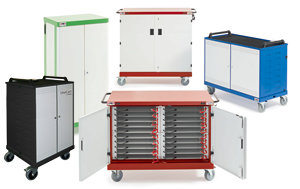Soft-start or load-protection
For some reason, soft-start, also known as load-protection, has been called many different things by manufacturers of laptop trolleys. However, no matter what the name, the functionality is the same.
Soft-start (not to be confused with surge protection) is a system to prevent power surging to all of the laptops at once when the laptop trolley is switched on. As a result, soft-start is designed to prevent a laptop trolley tripping a building’s fuses and is a must-have standard safety feature to look out for.
Anti-jemmy plates
Anti-jemmy plates are only found on metal laptop trolleys and are a type of security feature. These metal plates are designed to prevent thieves accessing a laptop trolley, and thus its contents, with a crowbar and are often fitted around a trolley’s doors. When the doors are closed, they will slot into these plates, making it difficult to attempt to pry the doors open. Different manufacturers will use different thicknesses of metal to make the anti-jemmy plates, and some laptop trolleys will have more anti-jemmy plates than others, making them more secure.
{googleAds}<script type="text/javascript"><!--
google_ad_client = "ca-pub-9940670887654728";
/* Expert Articles 468x60 */
google_ad_slot = "7545621260";
google_ad_width = 468;
google_ad_height = 60;
//-->
</script>
<script type="text/javascript"
src="http://pagead2.googlesyndication.com/pagead/show_ads.js">
</script>{/googleAds}
Power management
This phrase can cause a lot of confusion for schools because almost every manufacturer of laptop trolleys means something different when they use it. Power management normally refers to the way in which the electricity that charges the laptops is controlled inside the cabinet and is perhaps the most important thing to consider because it can impact upon pupil safety and the battery life of your laptops. Some laptop trolleys use a timer as a simplistic way of managing power inside the trolley, with other laptop trolleys using more sophisticated systems that detect exactly when a laptop has finished charging, and then turn it into standby mode.
Surge protection
Surge protection, or in-rush surge protection, is different to soft-start, but is another way to deal with something called ‘in-rush current’. If there is a surge, or sudden rush of electricity, caused by a lightning strike or a switch at the National Grid, surge protection absorbs the electricity to protect fuses being tripped. This safety feature also protects the laptops inside the laptop trolley from any damage that a surge could cause.
Mains conditioning
Mains conditioning filters the electricity to handle electrical spikes and smaller upsets in the electrical supply. Probably the best examples of mains conditioning are when a fridge turns itself on or off and causes a small fluctuation in the building’s electrical circuit, or when a light switch makes a ‘pop’ sound when it is turned on. Again, this is another vital requirement for laptop trolleys to protect the laptops themselves. Also filtering is essential to ensure the cabinet meets Electro Magnetic Compatibility (EMC) directives.
Residual voltage protection or anti-backwash protection
The term refers to the voltage that appears at the plug pins, for a short period of time when a plug is removed from the power socket. Residual voltage protection does not allow any residual voltage to escape from the laptop trolley once it is switched off, which could cause an electrical shock.
I hope that the above explanations take some of the confusion out of your search for a laptop trolley and makes things a little easier for your school.
| Learn more... |
Check out Innovate My School's Laptop Storage & Charging directory for a range of solutions on the market.


















